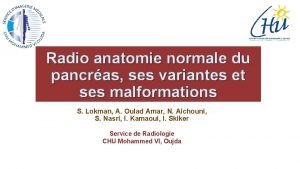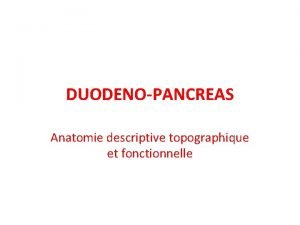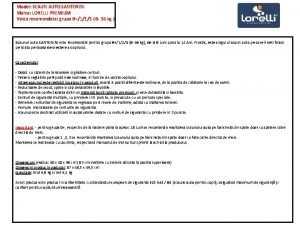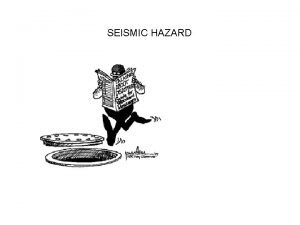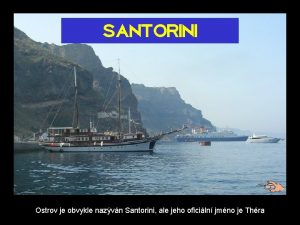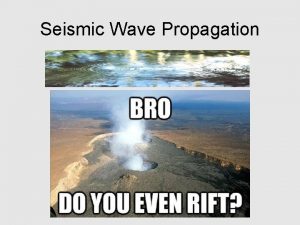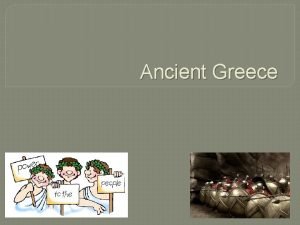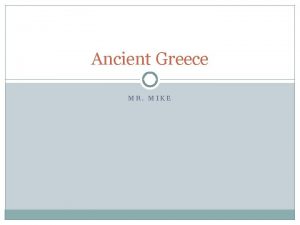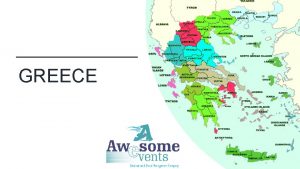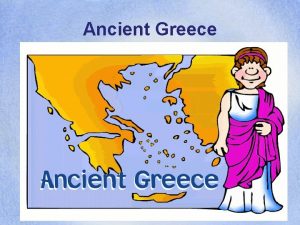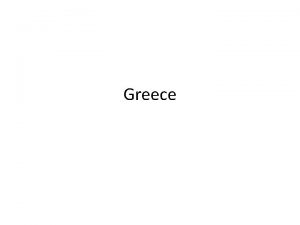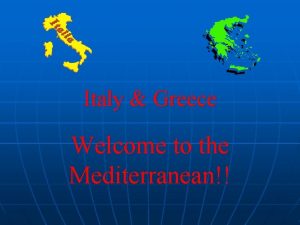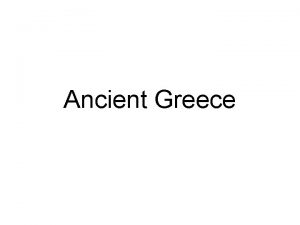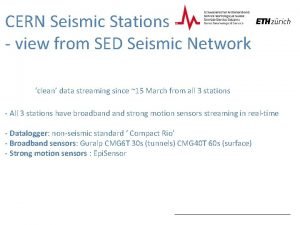The 2011 seismic crisis at Santorini Greece new






















- Slides: 22

The 2011 seismic crisis at Santorini (Greece): new insights from fluid geochemistry of submarine and subaereal emissions

Santorini: location and type of activity Volcanism at Santorini started about 2 million years ago from vents in the area of the present-day Akrotiri peninsula. The most characteristic type of activity over the last 200. 000 years has been the cyclic construction of shield volcanoes interrupted by large explosive and destructive events, like the Minoan eruption.

Santorini: past eruptions At least 12 strong eruptions have occorred in the last 200. 000 years. The Minoan eruption (1650 BC) has been one of the biggest in the last 10. 000 years, . The tsunami generated by this eruption may have canceled the Minoan civilization in Crete Island. The legend of Atlantis has been related to this eruption. Intense volcanic activity have occurred inside the caldera giving rise the rising of a new small island (Nea Kameni) during the year 197 BC. At least 8 eruptive phases followed in the years 46/47, 726, 1570 -1573, 1707 -1711, 1866 -1870, 1925 -1928, 19381941 and 1950 as the most recent eruption.

Santorini: submarine hydrothermal activity Many hydrothermal vents are present within the Santorini caldera (red dots). The black lines show the track of ROV Hercules on the caldera floor. A picture of the low temperature hydrothermal mounds in the northern part of the Santorini caldera. Diameter of the mounds is of the order of a meters.

The monitoring network Institute for the Study and Monitoring of the Santorini Volcano (ISMOSAV) • Sea level changes • GPS measurement (21 sites) • 10 EDM stations • 5 seismic stations • Soil temperature (continuous at Palea Kameni) • CO 2 flux monitoring

Sesmic activity: signs of a crisis

Sesmic activity: signs of a crisis The seismic events are mainly occurring along the NE-trending tectonic alignment connecting Thira and Kolumbo volcano

What’s Kolumbo ? Kolumbo is an active submarine volcano in the Aegean Sea, about 8 km northeast of Cape Kolumbo in Santorini island. The largest of a line of about twenty submarine volcanic cones extending to the northeast from Santorini, It is about 3 km in diameter with a crater 1. 5 km across. The crater bottom is at about 500 m b. s. l. , whereas the highest parts of the crater rim are now about 10 m below sea level. From the depth of ≈ 200 m it forms a sort of “intramarine stratified basin”.

The Santorini-Kolumbo megasystem

Kolumbo: the hydrothermal activity In 1650 an eruption occurred from this volcano. The accumulating cone reached the surface, sent pyroclastic flows across the sea surface to the shores and slopes of Santorini, where about seventy people and many animals died. Presently, several hightemperature (up to 224 °C) hydrothermal vents are recognized in the NE zone of the Kolumbo submarine crater.

A first hazard evaluation New activity is expected to occur at Nea Kameni, but also along the tectonic alignment connecting Thera and Kolumbo.

A first geochemical approach: isotopic signature and efflux of CO 2 from the soil of Santorini Most samples have compositions consistent with mixing between a low CO 2 ‘air’ component (350 – 500 ppm CO 2, d 13 C from -9 to – 11) and a high CO 2, ‘deep’ component, with d 13 C ~ -0. 2

Fluid geochemistry The sampling sites The submerged gas discharges are at depths ranging from 0. 5 (shoreline of Nea Kameni) to 21 m. Hot springs have been recognized at both Nea Kameni (depth of ≈ 50 m) and Santorini (along the shoreline and at depth > 100 m) islands. Subaereal fumaroles (max T ≈ 95°C) are located at the summit craters of Nea Kameni island.

Submarine and subaereal activity at Nea Kameni

Previous data • The fumaroles are strongly affected by air contamination, thus they are generally not monitored. Few (bad) data exist. • The submerged emissions have never been geochemically investigated. They are only considered a nice touristic place.

plastic funnel vacuum vial filled with a Na. OH + Cd(OH)2 suspension

A geochemical point of view General features of the fumarolic fluid composition Both subaereal and submarine gas discharges have 4 main components: 1. The deep gas (magmatic): CO 2 2. The hydrothermal component: CH 4 3. The temperature-sensitive component: H 2 4. Air: N 2 + O 2 + Ar

Temporal evolution of gas composition Subaereal 2010 2011 Submarine

Temporal evolution of gas composition Subaereal Increase of the high temperature compound (H 2), likely produced by water cracking. A “flash” process providing a quanlitative indication. Heat lateral transfer 2011 Heat vertical transfer 2010 Submarine Moderate increase of the high temperature compound (H 2), Increase of the hydrothermal component (CH 4). They are tools for evaluating the chemical-physical state of the hydrothermal-magmatic reservoir. An increase of 70 -100 °C was estimated

What’s happening ? Some perturbing event (new lava input? ) affected the deep magmatic system Enhanced convective heat transfer (evaluable on the basis of the chemical changes of the submerged emissions) provoked seismic signals focusing below Nea Kameni Effects of this perturbation are propagating toward Kolumbo through the regional fault system A cyclic event or… the beginning of a new stage of activity at Santorini?

Comments and suggestions Inland • Continuous measurements of geophysical signals in Nea Kameni’ • Multibeam sonar survey in between Thira and Kolumbo • Gas sampling of Nea Kameni fumaroles Underwater • Scuba surveys (visual and geochemical) of the submarine gas discharge sites • Direct observations (automated station) and gas and water sampling at the Kolumbo crater. • …the prefect site for studies aimed to investigate effects of endogenous emissions on marine species !!

 Isthme du pancréas
Isthme du pancréas Duct of santorini
Duct of santorini Ampoule duodénale
Ampoule duodénale Lorelli premium
Lorelli premium Santoriini
Santoriini Cholinergic crisis
Cholinergic crisis Hình ảnh bộ gõ cơ thể búng tay
Hình ảnh bộ gõ cơ thể búng tay Lp html
Lp html Bổ thể
Bổ thể Tỉ lệ cơ thể trẻ em
Tỉ lệ cơ thể trẻ em Gấu đi như thế nào
Gấu đi như thế nào Thang điểm glasgow
Thang điểm glasgow Bài hát chúa yêu trần thế alleluia
Bài hát chúa yêu trần thế alleluia Môn thể thao bắt đầu bằng từ chạy
Môn thể thao bắt đầu bằng từ chạy Thế nào là hệ số cao nhất
Thế nào là hệ số cao nhất Các châu lục và đại dương trên thế giới
Các châu lục và đại dương trên thế giới Công thức tính thế năng
Công thức tính thế năng Trời xanh đây là của chúng ta thể thơ
Trời xanh đây là của chúng ta thể thơ Cách giải mật thư tọa độ
Cách giải mật thư tọa độ 101012 bằng
101012 bằng Phản ứng thế ankan
Phản ứng thế ankan Các châu lục và đại dương trên thế giới
Các châu lục và đại dương trên thế giới Thơ thất ngôn tứ tuyệt đường luật
Thơ thất ngôn tứ tuyệt đường luật
